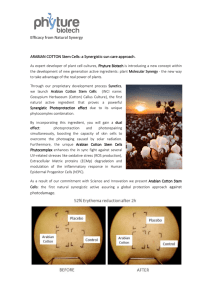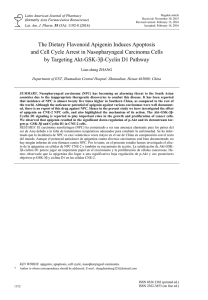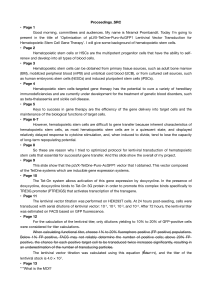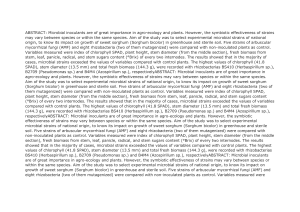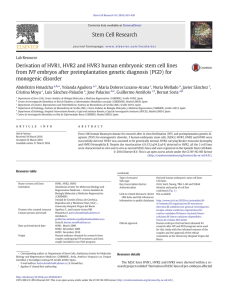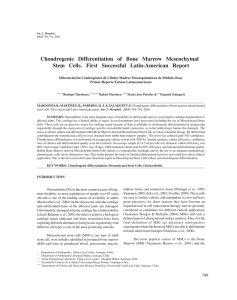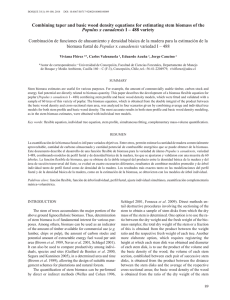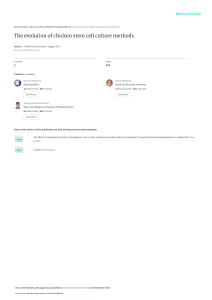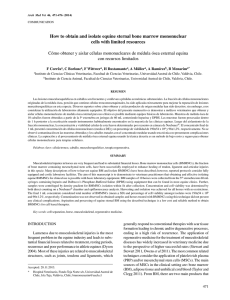Aislamiento y Mantenimiento de Stem Cells en Cultivo
Anuncio
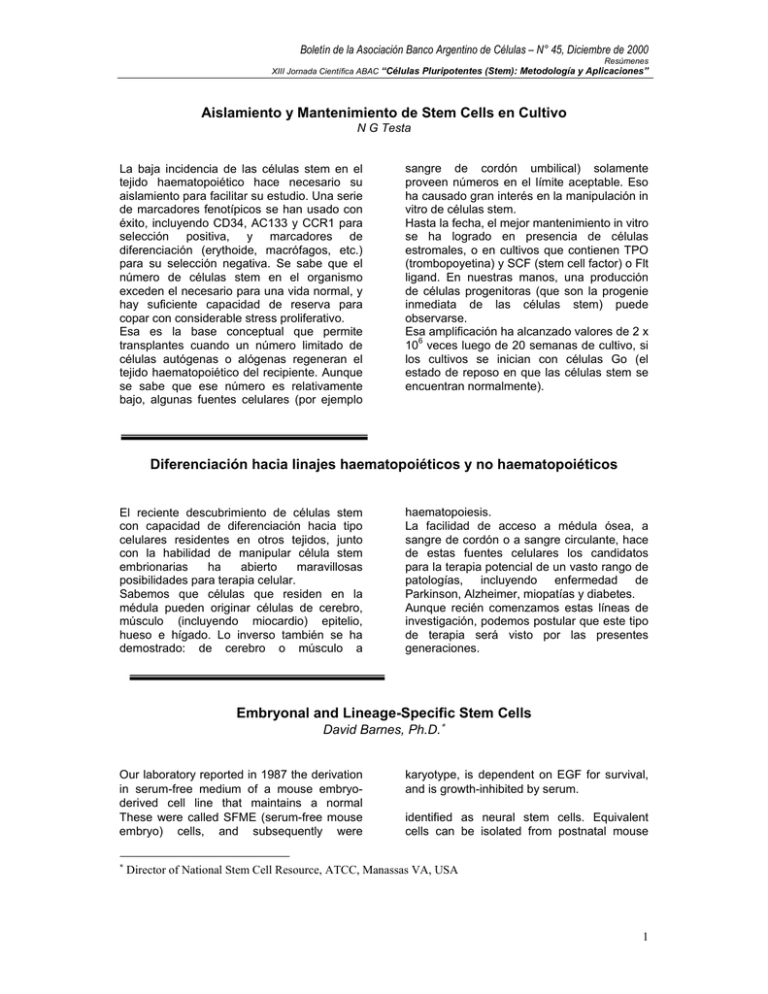
Boletín de la Asociación Banco Argentino de Células – N° 45, Diciembre de 2000 Resúmenes XIII Jornada Científica ABAC “Células Pluripotentes (Stem): Metodología y Aplicaciones” Aislamiento y Mantenimiento de Stem Cells en Cultivo N G Testa La baja incidencia de las células stem en el tejido haematopoiético hace necesario su aislamiento para facilitar su estudio. Una serie de marcadores fenotípicos se han usado con éxito, incluyendo CD34, AC133 y CCR1 para selección positiva, y marcadores de diferenciación (erythoide, macrófagos, etc.) para su selección negativa. Se sabe que el número de células stem en el organismo exceden el necesario para una vida normal, y hay suficiente capacidad de reserva para copar con considerable stress proliferativo. Esa es la base conceptual que permite transplantes cuando un número limitado de células autógenas o alógenas regeneran el tejido haematopoiético del recipiente. Aunque se sabe que ese número es relativamente bajo, algunas fuentes celulares (por ejemplo sangre de cordón umbilical) solamente proveen números en el límite aceptable. Eso ha causado gran interés en la manipulación in vitro de células stem. Hasta la fecha, el mejor mantenimiento in vitro se ha logrado en presencia de células estromales, o en cultivos que contienen TPO (trombopoyetina) y SCF (stem cell factor) o Flt ligand. En nuestras manos, una producción de células progenitoras (que son la progenie inmediata de las células stem) puede observarse. Esa amplificación ha alcanzado valores de 2 x 106 veces luego de 20 semanas de cultivo, si los cultivos se inician con células Go (el estado de reposo en que las células stem se encuentran normalmente). Diferenciación hacia linajes haematopoiéticos y no haematopoiéticos El reciente descubrimiento de células stem con capacidad de diferenciación hacia tipo celulares residentes en otros tejidos, junto con la habilidad de manipular célula stem embrionarias ha abierto maravillosas posibilidades para terapia celular. Sabemos que células que residen en la médula pueden originar células de cerebro, músculo (incluyendo miocardio) epitelio, hueso e hígado. Lo inverso también se ha demostrado: de cerebro o músculo a haematopoiesis. La facilidad de acceso a médula ósea, a sangre de cordón o a sangre circulante, hace de estas fuentes celulares los candidatos para la terapia potencial de un vasto rango de patologías, incluyendo enfermedad de Parkinson, Alzheimer, miopatías y diabetes. Aunque recién comenzamos estas líneas de investigación, podemos postular que este tipo de terapia será visto por las presentes generaciones. Embryonal and Lineage-Specific Stem Cells David Barnes, Ph.D.∗ Our laboratory reported in 1987 the derivation in serum-free medium of a mouse embryoderived cell line that maintains a normal These were called SFME (serum-free mouse embryo) cells, and subsequently were ∗ karyotype, is dependent on EGF for survival, and is growth-inhibited by serum. identified as neural stem cells. Equivalent cells can be isolated from postnatal mouse Director of National Stem Cell Resource, ATCC, Manassas VA, USA 1 Boletín de la Asociación Banco Argentino de Células – N° 45, Diciembre de 2000 Resúmenes XIII Jornada Científica ABAC “Células Pluripotentes (Stem): Metodología y Aplicaciones” brain as well, but with lower yields than from embryos. Similar results have been reported by Reynolds and Weiss, and these cells have recently been shown to also adopt a hematopoietic fate in vivo). SFME cells express astrocyte markers in the presence of transforming growth factor (TGF) beta. Cotman's laboratory has shown that SFME cells in the undifferentiated state also express nestin, a marker of neural stem cells, and Wang's laboratory showed that bone morphogenetic proteins influcence these cells in a manner similar to TGFbeta, with variable expression of neuronal markers in vitro. A collaboration with Drs. K. Nikolics and W. Gao at Genentech, Inc., showed that the cells differentiate into both neurons and glia when injected into developing mouse brains. Recent work in our laboratory has centered on the mechanism of apotosis and EGF signalling in these cells, with the identification of a novel tyrosine-phosphorylated EGF receptor substrate. In a second stem cell-related project, we are using zebrafish early embryo cell cultures. The laboratory identified in extracts of trout embryos a strong peptide growth factor-like mitogenic activity for fish cells (Collodi and Barnes, 1990). Using this approach, a zebrafish differentiation-competent embryonal stem cell-like system was developed). Schartl's laboratory recently has applied this approach to medaka, another fish model. Cells maintain a normal karyotype for more than two months in culture, and differentiation toward several lineages can be induced by treatment with retinoic acid or substratum manipulation. The methods developed in this laboratory for culture, DNA transfection and reintroduction of cultured cells into recipient embryos produced chimeric embryos in which cultured embryo cells contribute to the developing organism (Sun et al, 1995a,b; 1996). However, contribution to the germ line was very inefficient We have further explored the developmental status of these cultures by examining the expression of a variety of developmentally-regulated molecular markers: embryonal stem cell marker pou-2, primordial germ cell marker vas, neural markers krox-20, zp-50, en-3, pax[zf-a] and wnt-1, mesodermal markers ntl and gsc and muscle marker myoD. Marker expression was assayed using reverse transcription polymerase chain reaction (RT-PCR) with primer choices and methodology primarily devised within the lab. The influence of bFGF, a mesoderm inducer in many embryonal systems, was examined on the expression pattern of these markers (Singh et al., 2000). Previously we reported that FGF inhibits melanogenesis in the cultures. Upon exposure to FGF, pou-2 expression decreased, while vas expression remained constant. Predictably, bFGF treatment increased expression of ntl, gsc and myoD. In contrast, bFGF suppressed expression of neural markers. In situ hybridization identified a subpopulation of cells expressing pou-2, suggesting the possible continued existence of undifferentiated stem cells in the cultures Establishing and Maintaining a Stem Cell Resource Embryonal stem (ES) cells and lineagespecific stem cells provide essential models in studies of normal and abnormal biological processes. The availability and accessibility of research cells and other bioreagents is a driving, but rate-limiting, force in the effort to gain knowledge and understanding about stem cells and applications to disease processes. Perceived lack of availability of critical materials by the stem cell research community can limit creativity and innovation in research, particularily as applications expand from mouse to other species. Scientists may be hampered by a lack of knowledge of materials available from the community, concerns about reproducibility or stability of cells and other bioreagents, and restrictions on accessibility of materials because of shipping and regulatory problems. These limitations can be addressed by a central, internationally recognized Stem Cell Resource. Note: for the purposes of this application, "ES cells" refers to early embryoderived, genomically normal, proliferating cultures that can be manipulated to differentiate into representatives of all three germ layers. A critical in vivo characteristic of ES cells is the ability to contribute to germ line of chimeric animals, however, it is not practical at this point to test for germline contribution for ES cells from any animal other than mouse. A component of this application is a consortium arrangement with The Jackson Laboratories for testing of mouse ES cell lines for germline contribution prior to distribution. 2 Boletín de la Asociación Banco Argentino de Células – N° 45, Diciembre de 2000 Resúmenes XIII Jornada Científica ABAC “Células Pluripotentes (Stem): Metodología y Aplicaciones” Materials stored at and distributed from the Resource should represent a wide range of agents, including stem cells, feeder layers, hybridomas, molecular clones, expression vectors, polyclonal and monoclonal antibodies and synthetic peptides. A critical component, as well, is a Resource-based system for distribution and exchange of information and ideas among investigators. A Stem Cell Resource also can provide a mechanism for focused research to improve the Resource as it develops. In addition to work directly related to maximizing the capability of the Resource, it's unique position can facilitate comparative cross-species examination of culture conditions, cytogenetics, marker expression, feeder-layer dependency, genetic manipulation and other issues. Another benefit of this approach is the evaluation and standardization of reagents (monoclonal and polyclonal sera, medium components, molecular biological reagents, feeder cells) with regard to optimal concentration and protocol, stability and stem cell line/species specificity. A unified Resource providing such diverse items as characterized cells from a variety of species delivered live or frozen, reagents of a variety of categories, and up-todate information, including comparative and evaluative information generated in-house, should greatly improve investigator efficiency, and could not be accomplished without a well supported effort directed specifically toward these goals. Necessary functions involved in the establishment and successful maintenance of such a resource include: (1) forming and using advisory committees; (2) proactively accessioning reagents; (3) producing and expanding cell cultures, hybridomas, molecular biological reagents (cDNAs, vectors, oligonucleotide probes and primers) and other related reagents; (4) implementing appropriate quality control; (5) maintaining large and diverse databases; (6) receiving, aliquoting and storing reagents and developing bioreagent kits; (7) processing domestic and foreign orders for biomaterials; (8) maintaining distribution records and accurate inventories while shipping large numbers of bioreagents; (9) collecting fees and shipping costs for distributed reagents and obtaining proper assurance, release, and indemnity forms from recipients of materials; (10) engaging in Resource-related research; (11) disseminating information about availability and properties of reagents through hardcopy catalogs, via the internet and through other, electronic venues, such as CDROMs. The latter functions point out a significant difference between a "Resource" and a simple "Repository". Beyond the efficient acquisition, preservation and distribution of materials (Repository function), the Stem Cell Resource should be dedicated to an interactive environment facilitating user success with the materials provided and, furthermore, should be committed to dynamic and progressive conceptual advance in addition to progressive material acquisition. 3
